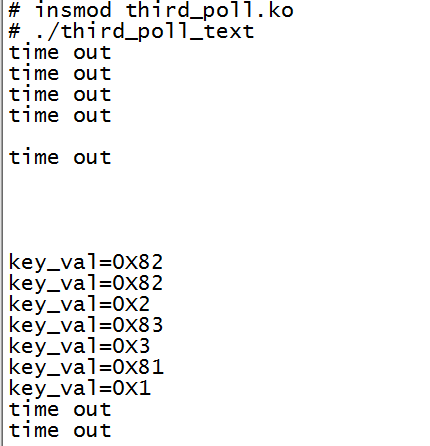本节继续在上一节中断按键程序里改进,添加poll机制.
那么我们为什么还需要poll机制呢。之前的测试程序是这样:
while (1)
{
read(fd, &key_val, 1);
printf("key_val = 0x%x
", key_val);
}
在没有poll机制的情况下,大部分时间程序都处在read中休眠的那个位置。如果我们不想让程序停在这个位置,而是希望当有按键按下时,我们再去read,因此我们编写poll函数,测试程序调用poll函数根据返回值,来决定是否执行read函数。
poll机制作用:相当于定时器,设置一定时间使进程等待资源,如果时间到了中断还处于睡眠状态(等待队列),poll机制就会唤醒中断,获取一次资源
1.poll机制内核框架
如下图所示,在用户层上,使用poll或select函数时,和open、read那些函数一样,也要进入内核sys_poll函数里,接下来我们分析sys_poll函数来了解poll机制(位于/fs/select.c)

1.1 sys_poll代码如下:
asmlinkage long sys_poll(struct pollfd __user *ufds, unsigned int nfds,long timeout_msecs) { if (timeout_msecs > 0) //参数timeout>0 { timeout_jiffies = msecs_to_jiffies(timeout_msecs); //通过频率来计算timeout时间需要多少计数值 } else { timeout_jiffies = timeout_msecs; //如果timeout时间为0,直接赋值 } return do_sys_poll(ufds, nfds, &timeout_jiffies); //调用do_sys_poll。 }
1.2 然后进入do_sys_poll(位于fs/select.c):
int do_sys_poll(struct pollfd __user *ufds, unsigned int nfds, s64 *timeout) { ... ... /*初始化一个poll_wqueues变量table*/ poll_initwait(&table); ... ... fdcount = do_poll(nfds, head, &table, timeout); ... ... }
1.3进入poll_initwait函数,发现主要实现以下一句,后面会分析这里:
table ->pt-> qproc=__pollwait; //__pollwait将在驱动的poll函数里的poll_wait函数用到
1.4然后进入do_poll函数, (位于fs/select.c):
static int do_poll(unsigned int nfds, struct poll_list *list, struct poll_wqueues *wait, s64 *timeout) { …… for (;;) { …… set_current_state(TASK_INTERRUPTIBLE); //设置为等待队列状态 ...... for (; pfd != pfd_end; pfd++) { //for循环运行多个poll机制 /*将pfd和pt参数代入我们驱动程序里注册的poll函数*/ if (do_pollfd(pfd, pt)) //若返回非0,count++,后面并退出 { count++; pt = NULL; } } …… /*count非0(.poll函数返回非0),timeout超时计数到0,有信号在等待*/ if (count || !*timeout || signal_pending(current)) break; …… /*进入休眠状态,只有当timeout超时计数到0,或者被中断唤醒才退出,*/ __timeout = schedule_timeout(__timeout); …… } __set_current_state(TASK_RUNNING); //开始运行 return count; }
1.4.1上面do_pollfd函数到底是怎么将pfd和pt参数代入的?代码如下(位于fs/select.c):
static inline unsigned int do_pollfd(struct pollfd *pollfd, poll_table *pwait) { …… if (file->f_op && file->f_op->poll) mask = file->f_op->poll(file, pwait); …… return mask; }
上面file->f_op 就是我们驱动里的file_oprations结构体,如下图所示:

所以do_pollfd(pfd, pt)就执行了我们驱动程序里的.poll(pfd, pt)函数(第2小节开始分析.poll函数)
1.4.2当poll进入休眠状态后,又是谁来唤醒它?这就要分析我们的驱动程序.poll函数(第2小节开始分析.poll函数)
2写驱动程序.poll函数,并分析.poll函数:
在上一节驱动程序里添加以下代码:
#include <linux/poll.h> //添加头文件
/* .poll驱动函数: third_poll */ static unsigned int third_poll(struct file *fp, poll_table * wait) //fp:文件 wait: { unsigned int mask =0; poll_wait(fp, &button_wait, wait); if(even_press) //中断事件标志, 1:退出休眠状态 0:进入休眠状态 mask |= POLLIN | POLLRDNORM ; return mask; //当超时,就返给应用层为0 ,被唤醒了就返回POLLIN | POLLRDNORM ; } static struct file_operations third_drv_fops={ .owner = THIS_MODULE, .open = third_drv_open, .read = third_drv_read, .release=third_drv_class, .poll = third_poll, //创建.poll函数 };
2.1 在我们1.4小节do_poll函数有一段以下代码:
if (do_pollfd(pfd, pt)) //若返回非0,count++,后面并退出 {
count++; pt = NULL; }
且在1.4.1分析出: do_pollfd(pfd, pt)就是指向的驱动程序third_poll()函数,
所以当我们有按键按下时, 驱动函数third_poll()就会返回mask非0值,然后在内核函数do_poll里的count就++,poll机制并退出睡眠.
2.2分析在内核中poll机制如何被驱动里的中断唤醒的
在驱动函数third_poll()里有以下一句:
poll_wait(fp, &button_wait, wait);

如上图所示,代入参数,poll_wait()就是执行了: p->qproc(filp, button_wait, p);
刚好对应了我们1.3小节的:
table ->pt-> qproc=__pollwait;
所以poll_wait()函数就是调用了: __pollwait(filp, button_wait, p);
然后我们来分析__pollwait函数,pollwait的代码如下:
static void __pollwait(struct file *filp, wait_queue_head_t *wait_address,poll_table *p) { ... ... //把current进程挂载到&entry->wait下 init_waitqueue_entry(&entry->wait, current); //再&entry->wait把添加到到button_wait中断下 add_wait_queue(wait_address, &entry->wait); }
它是将poll进程添加到了button_wait中断队列里,这样,一有按键按下时,在中断服务函数里就会唤醒button_wait中断,同样也会唤醒poll机制,使poll机制重新进程休眠计数
2.3 驱动程序.poll函数返回值介绍
当中断休眠状态时,返回mask为0
当运行时返回:mask |= POLLIN | POLLRDNORM
其中参数意义如下:
|
常量 |
说明 |
|
POLLIN |
普通或优先级带数据可读 |
|
POLLRDNORM |
normal普通数据可读 |
|
POLLRDBAND |
优先级带数据可读 |
|
POLLPRI |
Priority高优先级数据可读 |
|
POLLOUT |
普通数据可写 |
|
POLLWRNORM |
normal普通数据可写 |
|
POLLWRBAND |
band优先级带数据可写 |
|
POLLERR |
发生错误 |
|
POLLHUP |
发生挂起 |
|
POLLNVAL |
描述字不是一个打开的文件 |
所以POLLIN | POLLRDNORM:普通数据可读|优先级带数据可读
mask就返回到应用层poll函数,
3.改进测试程序third_poll_text.c(添加poll函数)
在linux中可以通过man poll 来查看poll函数如何使用
poll函数原型如下(#include <poll.h>):
int poll(struct pollfd *fds, nfds_t nfds, int timeout);
参数介绍:
1) *fds:是一个poll描述符结构体数组(可以处理多个poll),结构体pollfd如下:
struct pollfd { int fd; /* file descriptor 文件描述符*/ short events; /* requested events 请求的事件*/ short revents; /* returned events 返回的事件(函数返回值)*/ };
其中events和revents值参数如下:
|
常量 |
说明 |
|
POLLIN |
普通或优先级带数据可读 |
|
POLLRDNORM |
normal普通数据可读 |
|
POLLRDBAND |
优先级带数据可读 |
|
POLLPRI |
Priority高优先级数据可读 |
|
POLLOUT |
普通数据可写 |
|
POLLWRNORM |
normal普通数据可写 |
|
POLLWRBAND |
band优先级带数据可写 |
|
POLLERR |
发生错误 |
|
POLLHUP |
发生挂起 |
|
POLLNVAL |
描述字不是一个打开的文件 |
2) nfds:表示多少个poll,如果1个,就填入1
3) timeout:定时多少ms
返回值介绍:
返回值为0:表示超时或者fd文件描述符无法打开
返回值为 -1:表示错误
返回值为>0时 :就是以下几个常量
|
常量 |
说明 |
|
POLLIN |
普通或优先级带数据可读 |
|
POLLRDNORM |
normal普通数据可读 |
|
POLLRDBAND |
优先级带数据可读 |
|
POLLPRI |
Priority高优先级数据可读 |
|
POLLOUT |
普通数据可写 |
|
POLLWRNORM |
normal普通数据可写 |
|
POLLWRBAND |
band优先级带数据可写 |
|
POLLERR |
发生错误 |
|
POLLHUP |
发生挂起 |
|
POLLNVAL |
描述字不是一个打开的文件 |
最终改进的测试代码如下:
#include <sys/types.h> #include <sys/stat.h> #include <fcntl.h> #include <stdio.h> #include <string.h> #include <poll.h> //添加poll头文件 /*useg: thirdtext */ int main(int argc,char **argv) { int fd,ret; unsigned int val=0; struct pollfd fds; //定义poll文件描述结构体 fd=open("/dev/buttons",O_RDWR);
if(fd<0) {printf("can't open!!! "); return -1;} fds.fd=fd; fds.events= POLLIN; //请求类型是 普通或优先级带数据可读 while(1) { ret=poll(&fds,1,5000) ; //一个poll, 定时5000ms,进入休眠状态 if(ret==0) //超时 { printf("time out "); } else if(ret>0) //poll机制被唤醒,表示有数据可读 { read(fd,&val,1); //读取一个值 printf("key_val=0X%x ",val); } } return 0; }
效果如下:

若5S没有数据,则打印time out
下节开始学习——使用异步通知来通知信号